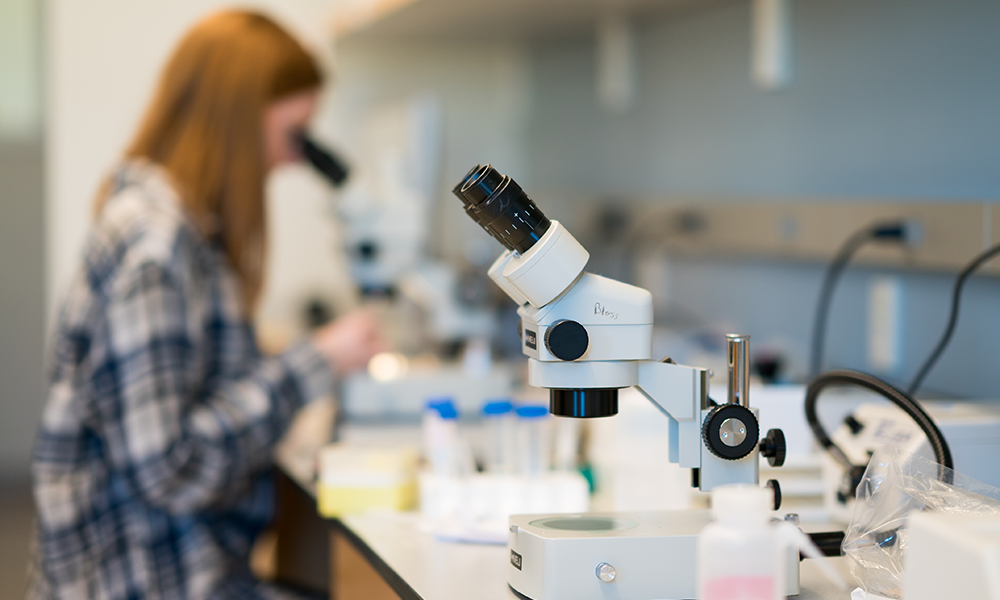Big grant funds investigation of life’s earliest stages
JMU News
A small group of biology students began combing through data during the fall semester, looking for potential experiments to run in future semesters to kickoff a four-year research program backed by $1 million from the National Science Foundation.
Led by Dr. Casonya Johnson, academic unit head of biology, the research hopes to shed light on the ways a certain group of proteins regulate gene development in the early stages of life, just after egg fertilization.
Through a combination of course-based undergraduate research experiences (CUREs) and independent mentored research, undergraduate students will use genetics, molecular biology, mathematical modeling and artificial neural networks to model protein-DNA interactions that regulate gene expression. In addition to undergraduates who will earn stipends for their work, some students will participate in the project for course credit. The grant also funds work by master’s degree students.
The first students working on the research are biology and computer science majors, but Johnson is hoping to recruit students from other disciplines as the project progresses. “One of the reasons we are excited is because it gives us an opportunity to take students from other fields,” she said. In addition to biology, the research will involve chemistry, computer science, mathematics and physics.
While answering questions about how HES proteins do their job is a focus of the grant, Johnson is equally excited about the program’s other goals, assessing how much students actually learn while participating in course-based research and attracting more students from underrepresented groups to participate in research.
“One of our overall objectives is to understand and to help students understand how they develop a science identity in spite of their cultural background,” said Johnson, who is Black and who grew up in a community where many people did not have a good understanding of what biologists do. “Usually scientists have one thing in common, their sense of exploration and the questions that they want to ask. Sometimes, in some communities, that’s not so appreciated,” she said. “It’s also not easy to strive to be a scientist when you feel alone and isolated.”
One way Johnson hopes to reach a diverse group of students is through a workshop called Representation Matters. Co-hosted by the Biology Students of Color organization, the first Representation Matters workshop will be held during the spring 2021 semester, although not in the fashion Johnson had hoped due to the lingering COVID-19 pandemic. Originally, the workshop was going to feature scientists of different cultural backgrounds and at different stages in their careers working in-person with students. That will now happen virtually. Johnson hopes that future workshops, planned for spring 2022 and spring 2023, will be conducted in person.
Recruiting students from groups underrepresented in STEM is not a specific goal of the grant, Johnson said, but she hopes to make those students more aware of research taking place at JMU and to encourage them to reach out for it.
Biology professor Patrice Ludwig will lead the learning assessment part of the research to determine how much students are learning in such a program, how teachers can teach across disciplines and also how to develop curriculum that is effective at teaching both college and high school students. Dr. Ludwig will work with biology instructor Caylin Murray to design and integrate the CURE component into the genetics classes so that many biology majors can participate in some aspects of the project.
Dr. Chia-Hsuan Yang, a professor of integrated science and technology, will lead students in modeling that can predict how the HES proteins work beyond the early stages, while also developing a new interdisciplinary research course that teaches undergraduates from different science majors to develop common approaches for understanding how proteins and DNA communicate.
“Once we answer this question for the transcription factor at one state in the animal, at one given small snapshot, we can use that answer to figure out how these proteins are supposed to function on a grander scale and that gives us ways to now say, ‘What exactly is it doing when we’re looking at it in disease or when things are not functioning properly and can we predict what will happen if we target this protein later on for some other application,’” Johnson said.
The research will be conducted with Caenorhabditis elegans, a tiny microscopic worm that shares many of the essential biological characteristics of human biology.
Media contact: Eric Gorton, gortonej@jmu.edu, 540-908-1760.
# # #
